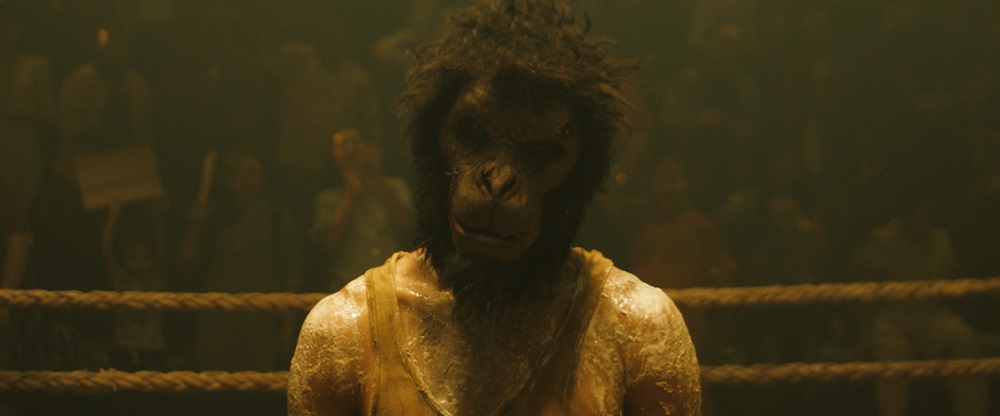
Dev Patel’s Strikingly Personal Monkey Man is an Action-Heavy Fight for Acceptance
Dev Patel’s action-heavy directorial debut Monkey Man crams a lot into its breakneck, 121-minute running time, ambitiously attempting to meld three of four stories into a coherent whole. While the Academy Award–nominated actor (for Lion) isn’t entirely successful, there is so much flamethrowing storytelling panache that I still walked out of the theater impressed.
The film’s foundation is built on a familiar tale of revenge, all of it centered on an underground fight-club baddie wearing a monkey mask nicknamed “Kid” (Patel), who is routinely tasked with dominating his bouts before throwing them in the latter rounds by the venue’s South African emcee Tiger (Sharlto Copley). But Kid’s true goal is to get close to the corrupt chief of police Rana (Sikandar Kher). He’ll do whatever he has to if it means he’ll get to put a bullet between the eyes of the man responsible for murdering his mother Neela (Adithi Kalkunte), even if the cost is his own life.
All of that basically makes up the first third of the picture. Patel doesn’t spend a ton of time fleshing things out in any detail. Kid goes from being at the fight club to worming his way into the swanky King’s Club (which doubles as a den of inequity for India’s ruling elite), run by the ruthless Queenie (Ashwini Kalsekar), to finally making friends with slimy underworld gofer Alphonso (Pitobash). The latter is the one person who can get the single-minded young man next to his intended prey — and all hell inevitably breaks loose once this does indeed happen.
The next section finds Kid rescued by a close-knit band of hijra, third-gender outcasts who were once revered in Hindu culture but now mostly live in seclusion for fear of persecution (or worse). Led by the kindly Alpha (Vipin Sharma), this community of mystics nurses the film’s protagonist back to health both physically and spiritually. They force Kid to face his childhood trauma while also opening his eyes to the bigger political and cultural picture currently happening in India. Turns out that revered guru Baba Shakti (Makarand Deshpande) is not the benevolent holy man he pretends to be but instead the manipulative, Machiavellian brains behind multiple evils, and Rana is the powerful enforcer happily carrying out his bidding.
The final third is where everything comes together, pretty much at the exact same time. Events get wrapped up at the fight club with Tiger. Kid returns to King’s Club to finish what he started, only this time for the good of all. The hijra embrace their historical roots and become heroines fighting, not just for their own right to exist but for all of India’s forgotten and marginalized citizenry cowering silently in the shadows.
Patel doesn’t quite get a handle on all of this. He introduces a series of flashbacks depicting Kid’s relationship with Neela along with her tragic encounter with Rana, and while there are times these scenes have an otherworldly, haunting splendor, they just as regularly stop the film’s momentum cold.
The director, especially during that first third, also utilizes a handheld kinetic style of action filmmaking reminiscent of what Paul Greengrass perfected in his trifecta of The Bourne Supremacy, United 93, and The Bourne Ultimatum. But Patel doesn’t have the same pinpoint control of this method that Greengrass does, and because of this, there are moments when Monkey Man becomes nothing more than a hyperactive mess.
But suddenly, a masterful car chase bleeds into an exhilarating rooftop pursuit that culminates in the shocking, quiet introduction of the hijra, and I sprang forward to the edge of my seat in fascinated awe. Patel finds his footing again. The film’s editing style, while still frenetic, now becomes more purposeful, more driven by what is happening to the characters and less to augment the action pyrotechnics. It is also here that cinematographer Sharone Meir (Whiplash, Silent Night) fully flexes his visual muscles, turning the entire climax inside the various corridors, kitchens, and party rooms of King’s Club into something out of a beauteous nightmare.
Every scene with the hijra is extraordinary, including three background supporting performances by hijra actors Pehan Abdul, Dayangku Zyana, and Reva Marchellin. The veteran Sharma exudes wisdom, compassion, and warmth. Patel paints every conceivable detail with an inquisitive eye, his deeply empathetic portrait of this community overflowing with tenderness, respect, and even delightful jolts of unexpected humor. This segment becomes the heart and soul of the overarching narrative, and what began for Kid as a quest for revenge now turns into something far more universally urgent and profoundly humanistic.
Then there is that climax. A few goofy missteps aside (at one point Kid bleaches his fight club monkey mask white for the final battle, only to nonchalantly discard it before even stepping back inside King’s Club — and that’s only one instance of gonzo inanity), this exhilarating pugilistic bloodbath is still well worth the wait. Patel stages each encounter like the finale of Bruce Lee’s Game of Death. Every floor Kid ascends to comes with its own set of adversaries, and watching how he dispatches them all — sometimes with aid, usually without — is a vivacious, swirling jump-kick to the face.
Monkey Man isn’t without its faults, and it does take some time to find solid ground. But Patel shows directorial promise, displaying a uniquely personal vision that allows his film to defy simplistic genre classifications. He isn’t afraid to confront social and political hot topics, never playing coy about how his characters feel or what they are willing to give to fight for what they believe in. This makes Patel a vital cinematic voice, and I can’t wait to see what he does behind the camera next.
– Review reprinted courtesy of the SGN in Seattle
Film Rating: 2½ (out of 4)








